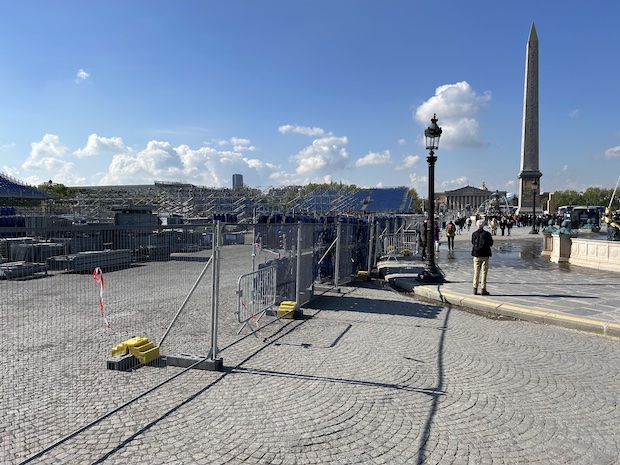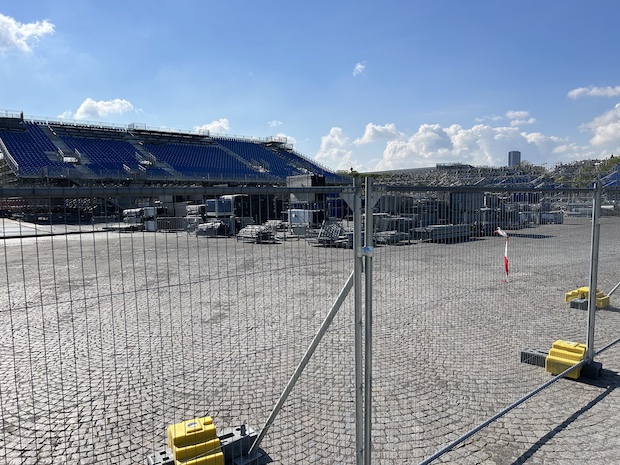Will Paris Be Ready for the Olympics?

The 2024 Olympic Games are little more than two months away. Hosted in Paris for the first time in a hundred years, it’s also a showcase for the so-called “new” Olympic model — requiring as little construction of new infrastructure as possible to reduce the bloat and expense of hosting a Games. To wit, over 75% of the venues for this year’s Games are existing stadiums or structures.
But despite this existing infrastructure, there’s still a mad dash to the finish in order to be prepared for opening day on July 26th. Here’s what we can share following a recent trip to the city.
Temporary Stadium Construction
The majority of temporary stadium construction is taking place around the city center, including a 30,000 person venue at Place de la Concorde, a 12,000 seat stadium near the Eiffel Tower, and an 8,000 person venue at Les Invalides.
It is these temporary structures that are most significantly behind schedule. According to local sources, some of these temporary facilities will require construction work up to the few minutes prior to events taking place in them. Of those, it is at Place de la Concorde — home of the 3×3 basketball, breakdancing, BMX freestyle, and skateboarding of events — that are most delayed. (They are also the ones pictured in this article).

For triathlon, there is minor construction on the Port Alexandre III bridge. (This is also the home of marathon swimming and the cycling time trial finish.) The venue is pretty much set.
Larger Infrastructure Projects and Their Impacts
Coincidental to the Olympics, there are two significant public works projects that may impact spectators and athletes alike.
The first is the expansion of the Metro system. During the bid process, an entire revamp of the Metro, including the so-called “Grand Paris Express” system was to be completed in time for the 2024 Games. That plan was scrapped in 2018. Instead, the major project planned to be complete in time for the Games is the expansion of the 14 line (or, as our daughter referred to it, the Purple Line).
The 14 is considered mission critical for athletes and spectators. The expansion sees the 14 extend all the way to Paris-Orly Airport, and connects to the Stade de France and the new aquatic center in Saint-Denis. Construction has been ongoing, with new control systems in place on the trains during our time in the city. The driverless trains had to be equipped with new software to handle the additional capacity and nearly 17 kilometers in additional track. It is anticipated that the expansion will officially launch in June, just one month before the Games.
The other major works has to do with water quality in the Seine. Numerous outlets have reported on poor water quality in the river, which will be home to marathon swimming and triathlon events. And it’s true — the Seine has had water quality issues this spring.
It all comes back to how sewer and stormwater is handled in older systems such as those utilized in Paris; namely, the sewer and stormwater lines are shared. When there’s too much rain, wastewater treatment plants can’t handle all the additional flow. With nowhere to go, it is then discharged out of the system. In this case, that’s directly into the Seine. It is not dissimilar to systems in many older cities in the United States located near water. If it rains a lot, there are water quality issues in otherwise swimmable venues.
Climate will help water quality in the Seine; rainfall amounts drop significantly in the summer months in Paris, with July usually receiving under 2.5 inches of rain during the month. That said, Paris has also finished construction and opened a 13.2 million gallon water basin to store sewage and stormwater in the event of flooding precipitation and prevent discharge into the Seine. It’s one of the last critical pieces of a 1.4 billion Euro project to make the Seine swimmable for the Olympics and beyond.
Will It Be Ready?
For athletes, most certainly.
For spectators? Like with most Olympics, the most likely outcome will be some slight frustration at venues. But between the core infrastructure, temporary stadiums, and improvements to the Metro, it should be a quality viewing experience as well.

